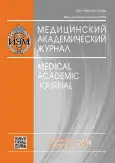THE AUTONOMIC NERVOUS SYSTEM IN THE CORRECTION OF FUNCTIONAL DISORDERS OF THE SMALL INTESTINE IN THE COMPLEX TREATMENT OF EXPERIMENTAL ETHANOL INTOXICATION
- Authors: Sluchanko EI1
-
Affiliations:
- Pskov State University, Pskov
- Issue: Vol 19, No 1S (2019)
- Pages: 153-155
- Section: Articles
- Published: 15.12.2019
- URL: https://journals.eco-vector.com/MAJ/article/view/19375
- ID: 19375
Cite item
Abstract
The work is devoted to fundamental medical and biological studies, which make it possible to understand the basic laws of photobiology, part of which is super venous laser irradiation of blood. Neurohistochemical, histochemical, and electrophysiological methods were studied in the Wistar rats morphofunctional state of the small intestine under the influence of the supravenous laser blood irradiation in the complex treatment of experimental ethanol intoxication.The importance of the autonomic nervous system in the understanding of the characteristics of the effect of superluminal laser irradiation of blood on biological tissues in the complex treatment of experimental ethanol intoxication is emphasized. Experimental pathogenetically justified use of laser stimulation initiates the activation of adaptive processes, which is reflected in the restoration of the motor function of the small intestine on the 3rd day after the treatment of ethanol intoxication. The changes observed by us under the influence of supravenous laser irradiation of blood can be estimated as a state of increased activation of autonomous regulatory systems of the small intestine. Normalization after the use of supravenous laser irradiation of blood imbalance of neuromediation in the tissues of the small intestine, the increased activity of the enzymes of the aerobic cycle in the muscular layer of the named intestine is a consequence of adaptive changes, which is reflected in the restoration of the motor function of the small intestine with ethanol intoxication.
Full Text
References
- Ablieva YA, Akimova MA, Bogdanov SI. Characteristics of anxiety-depressive disorders in patients with alcoholism in a narcological hospital GBOU VPO. Proceedings of the VI National Congress on Social Psychiatry and Addiction, May 18-20; 2016. P. 38.
- Shelygin KV, Kirpich IA, Leontiev VE, Soloviev AG. Use of animals in toxicological experiment: methodical recommendations. Ed. by P.I. Sidorov. Arkhangelsk: Publishing House of the Northern State Medical University; 2002. P. 19.
- Popov AI. Mathematical Models and a Complex of Programs for the Functional Diagnostics of Biomedical Signals of the Low-Frequency Range. Abstract. Petrozavodsk; 2010. P. 20.
- Stropus RA, Tamaškauskas KA, Yakubauskaite BB. The use of the point method for the quantitative study of nerve structures. General Patterns of Morphogenesis and Regeneration: Abstracts of a report of the 2nd scientific conference of anatomists, histologists, and embryologists of the Lithuanian SSR with the participation of the Baltic morphologists. November 2-3. 1976. Kaunas, 1976. P. 68.
- Shvalev VN. Age-related changes in the regulatory mechanisms of the cardiovascular system and the importance of nitric oxide synthase in health and pathology. Cardiology. 2007;5:67-72.
- Gatiatulina ER, Popova EV, Nikonorov AA, et al. Evaluation of tissue metal and trace element content in a rat model of non-alcoholic fatty liver disease using ICP-DRC-MS. Journal of Trace Elements in Medicine and Biology. 2017;39:91-99.
- Jakubczyk A, Klimkiewicz A, Mika K. Psychosocial predictors of impulsivity in alcohol-dependent patients. J. Nerv. Ment. Dis. 2013;201(1):43-47.
Supplementary files







